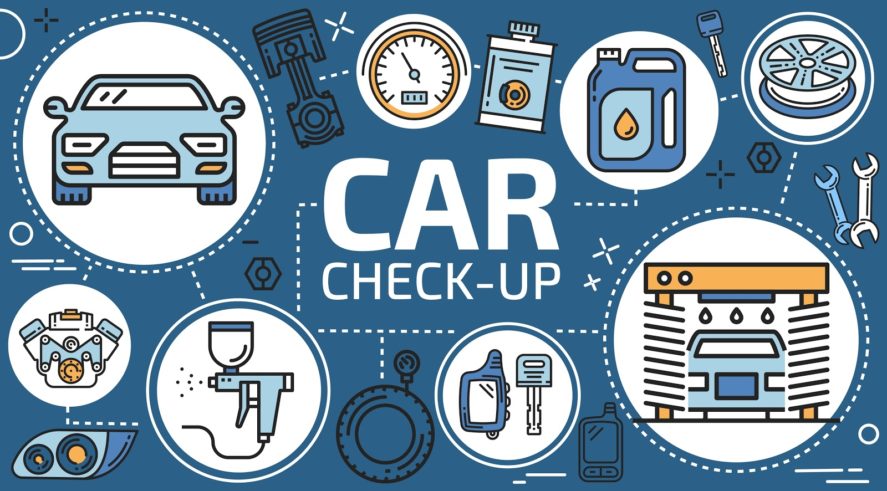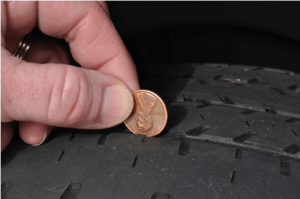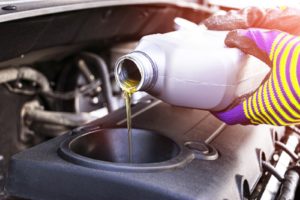
The colder temperatures and rainy conditions can be brutal on automobiles. Now that Spring has sprung and the winter weather is well behind us, it is time to conduct some routine car maintenance and give your vehicle an inspection. This will help prevent any unnecessary repairs down the road. We’ve put together a comprehensive car maintenance checklist so that you can spot hidden problems before they become more serious and costly.
Spring Car Maintenance Checklist To Save You Money
Routine car maintenance is something everyone can do to keep their vehicle in tip-top shape and operating smoothly for years to come. Things like checking the tire pressure, oil and replenishing engine fluids all help to make sure your car isn’t being put through unneeded strain. If you aren’t especially handy when it comes to automobiles, you can always opt to go to your dealership or local mechanic to have them conduct a thorough tune-up on your car.
1. Tire Maintenance – When you consider tire maintenance or replacement, you’ll get conflicting timelines from car dealers and tire manufacturers. Dealerships may suggest that you replace your tires every 5-6 years, while tire companies may steer you towards the 10-year mark. It all depends on the brand of tire though. Always check the guidelines that are offered with the brand and style of the tire you buy.
- Check Tire Pressure – If at all possible, try to check tire pressure when the tires are ‘cold’. Meaning when the tires haven’t been in use for a few hours. If not, try to drive to the nearest gas station, under a mile away, where you can find pressurized air with a PSI (pounds per square inch) pressure gauge on it. Make sure to refer to the car manufacturer’s recommended PSI for your vehicle and tire. To check your tire pressure, remove the valve cap from one tire at a time. You’ll need to check all four tires. Affix the pressure gauge on the valve stem of your tire. Press down until the hissing noise of air loss stops. Standard, gas station pressure gauges should have a bar with measurements on it that pop out with the PSI reading. Do this to all four tires and remember to write down what the PSI of each tire is and compare that to the recommended PSI in your car’s owner’s manual. If your tries have a low PSI, your tires are underinflated and you’ll want to add air. Be careful NOT to overinflate your tires with air.
- Check Tread – If your tires have worn tread it can make it more difficult for your car to grip the road. That is especially so in severe weather. In fact, having worn tread is considered a hazard in m
 ost states and is illegal. You can incur a fine if you are caught operating a vehicle with bald tires. To check to see if the tread on your tires is worn and it’s time for you to replace your tires, you can do something called the ‘penny test’.
ost states and is illegal. You can incur a fine if you are caught operating a vehicle with bald tires. To check to see if the tread on your tires is worn and it’s time for you to replace your tires, you can do something called the ‘penny test’.
-
- The Tire Penny Test: Grab a penny, and with Lincoln’s head facing down, insert the penny into the tread on your tires. If the rubber DOES NOT cover at least half of Lincoln’s face, then your tires need to be replaced. Repeat this around the circumference of each tire to check the depths of the tread on your tires.
2. Check Your Brakes & Brake Pads – You can mostly check your brakes by looking and listening. Inspect your brake pads with a flashlight. If the pads look thin, slimmer than ¼”, and have considerable wear, it may be time to replace your brake pads. You can check your brakes by listening to them when you drive. If you hear a screeching sound or find that you can’t come to a complete stop quickly and easily when you press on them, then you may want to take your car to a mechanic to get them properly inspected. Most modern vehicles have a warning light that it is time to check your brakes. Always adhere to your onboard alerts as they are great indicators that maintenance is needed.
3. Inspect Your Shock Absorbers & Struts – Shock absorbers function exactly as the name suggests, they absorb most of the shock your car endures on the road and provides the driver a smoother ride. If you notice that your car has an excessive bounce to it when you’re driving over speed bumps and other anomalies in the road, it is likely time to have your shocks and struts inspected and possibly replaced. Another indicator is if your steering seems off.
4. Quickly Inspect Wipers & Wiper Fluid – You may not think of it often, but your windshield wipers go through a lot of wear and tear no matter what part of the country you live in. During the winter months, your wipers can freeze and become cracked and brittle. The sun also works to dry your wipers out to the point the blade needs to be replaced. This is easy to check. Simply lift your wiper up and see that the wiper blade is in good condition. If it looks cracked, warped or the material is cracking, take a quick trip to an auto supply shop and purchase new wiper blades for under $20. Check that your wiper fluid is fresh and full. If it is running low, remember to fill it up to the wiper fluid line.
5. Check Under the Hood –

- Oil & Other Fluids – Pop the hood and do an inspection of all of your car’s fluids. Checking and changing your oil is vital to the health of your automobile. You’ll typically have a reminder sticker they give you when you get your oil changed that lets you know how many miles you have before your next oil change. If not, check your user manual to see how often your particular make and model of car needs to have the oil changed. The same applies to the other fluids in your vehicle that need to be checked. Things like power steering fluid, automatic transmission, and brake fluid levels all should be maintained and refreshed routinely. The frequency will depend on the age, make and model of your car. Remember to keep a schedule for all fluids in your car and follow it accordingly. For cars that have more mileage, it is even more important to stay on top of replenishing the fluids and checking your oil. If you are wondering why you need to get your oil changed and how often, you can read more about that here.
- Coolant & Radiator Fluid – Coolant and radiator fluid can be a bit tricker. If you aren’t that familiar with cars, you shouldn’t go tinkering with the radiator without prior knowledge. If you notice that your car is running hot, it is likely time to check to see that you have enough coolant. Refer to your owner’s manual for the recommended procedures and what type of coolant and fluids should be used in your car. Always be mindful of not overfilling your coolant and only fill if the levels are noticeably low. If there is visible rust forming on the inside of the tank, then you may need to have your radiator flushed.
- Belts & Hoses – This is another simple inspection that you can do just by popping the hood. When you’re finished checking all your fluids, check the belts and hoses for any indications of cracked or brittle hoses or belts. If you see that any of the belts or hoses are flaking or have pinhole leaks in them, you should absolutely contact your mechanic or dealership to have them replaced.
- Car Battery Health – There are a few indicators you should be on the lookout for when your car battery needs to be replaced. If you notice your car is slow to start, electrical issues, a bad smell coming from underneath the hood or you see corrosion on the connectors of your battery, it is likely you need a new car battery.
6. Inspect the Air Conditioner – Most everyone is familiar with the noise an A/C unit makes when it kicks on. You can hear the compressor kick into action to cool the air. That’s exactly what you’re going to want to listen for in this instance. With the car running, switch on your car’s air conditioning and listen for the compressor to kick on. If your A/C isn’t blowing out cool air, or the compressor doesn’t kick on, it may be an indicator that you don’t have enough refrigerant like freon or R-134 cycling through your air conditioning system. You can safely add refrigerant yourself, but you may want to contact a professional mechanic or your dealership first.
7. Wash & Wax Your Automobile – Regularly washing and waxing your car not only keeps it looking like new, but it can reveal minor dings and chipped paint that you should be aware of. Small cracks and chips in the paint of a vehicle is a breeding ground for rust. By finding these little deviations early, you can affordably fix them and prevent rust from settling in. For reference, here is a list of the best products to wash and wax your car with.
- Clean Headlights & Taillights, Bulb Replacement – While it is always important to give your headlamps, taillights, and blinkers a once over so that they are not blurred in any way, it is also important to check to see that they are all in working order. Having tail or brake lights that don’t function will earn you a hefty ticket if left unrepaired. A simple solution of baking soda and water will help make your headlamps shine brightly. To check that all of your lights are working properly, go through turning them all on and have a family member or friend give you the thumbs up or down to confirm they are working. If any of the lights have burned out, you’ll want to replace that as soon as possible.
8. Clean the Interior – The interior of your car shouldn’t get neglected either. Now that you have gone through your car maintenance checklist, put a little love into the inside of your car. Depending on your car’s interior, rubbing the seats down with leather cleaner or vacuuming the fabric seats is a great start. Polish up all the hardware and wipe down the dashboard and console in your vehicle with a product specially made for car interiors. Move to vacuuming all of the floorboards, car mats, seats and headrests (if fabric). And last but not least, don’t forget to clean out your trunk and vacuum it thoroughly.
CarWorld offers a large inventory of used sedans, midsize SUV, and SUVs, as well as a premium inventory of high-end vehicles. Visit our “buy here, pay here” dealership for help finding the vehicle you want and need. We are open during COVID-19 and taking the necessary precautions to keep you safe.
To learn more, trade-in your vehicle, and view our latest inventory, call (310) 644-9444 or visit our dealership at 11916 Prairie Ave. in Hawthorne. We also deliver the car or truck you purchase to your front door!